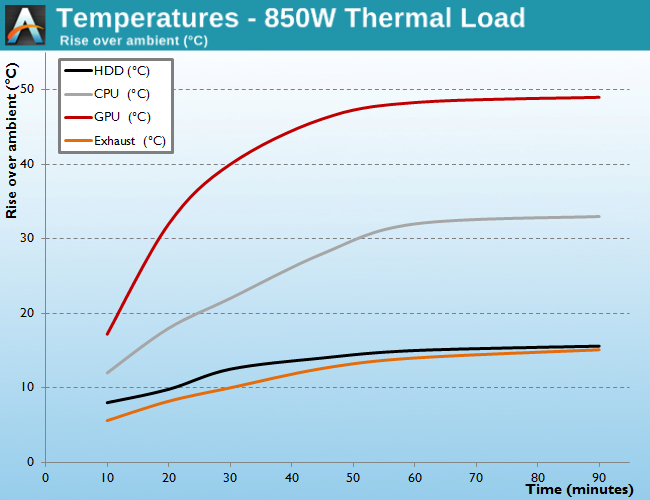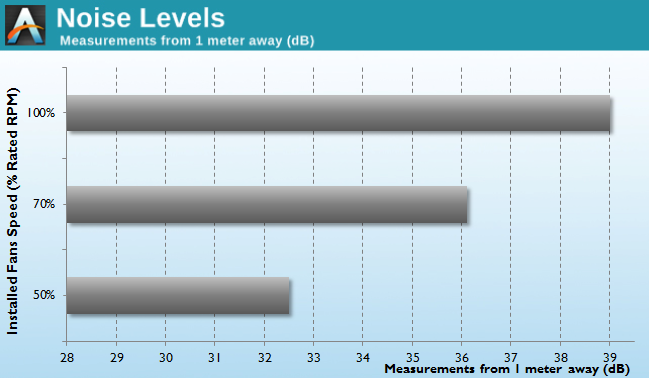Corsair Graphite 760T Case Review
by E. Fylladitakis on March 27, 2014 1:10 PM ESTTest Setup
Professional testing requires the emulation of real-world situations but with repeatable results; thus, a perfectly controllable test setup and environment are required, especially for comparable results. Testing the thermal performance of any case with a typical real-world setup technically limits the comparability of the results to this setup alone, as an active system interacts with its environment and the change of a single component alters (albeit in small ways) myriads of variables. In order to eliminate such factors, we developed synthetic loads that emulate the thermal output of real systems that are passive, steady and quantifiable.
Our thermal testing now displays the thermal capabilities of the case alone, as if it must deal with the entire thermal load by itself, regardless of the system that might be installed inside it. Laboratory data loggers are used to monitor the PT100 sensors and control the safety relays, which are fully accessible via our custom software. Three such loads have been developed, and today we'll be using the ATX load.
The ATX version simulates a 200W CPU, 50W VRM, 30W RAM and 4 × 120W GFX card thermal load; additionally, three 3.5" HDD dummy loads are also present that each convert 30W of electrical power to thermal, bringing the total thermal load of the ATX test setup up to 850W. As such, the thermal load is immense and only the best of cases will be able to handle it for more than a few minutes. We also test with a thermal load of 400W, with all of the aforementioned components except the HDD drives at about 42% power, which is more suitable for the majority of cases.
Thermal testing is performed with all of the case's stock fan operating at maximum speed. Noise testing is performed with a background noise level of 30.4dB(A).The top panel cover remained installed.
Results and Discussion
The thermal performance of the Corsair Graphite 760T is rather good but we cannot really claim that it is great considering the size and nature of the case. The stock cooling fans are not very powerful and ventilation depends on them while the top panel cover remains attached. It performed well enough to compete with mid-tower cases designed for maximum thermal performance, such as the Obsidian 450D, but the Graphite 760T is significantly larger and pricier.
The reduction of the load down to 400 Watts displays that the Graphite 760T has mediocre thermal inertia for a case this size. It appears that the thermal performance of the Graphite 760T heavily depends on the airflow of the cooling fans, at least while the top panel cover remains attached.
Probably due to the nature of the Graphite 760T, virtually no measures have been taken in order to reduce the noise coming from the case. Only the 3.5" devices are decoupled from the chassis; any vibrations from the PSU will be transferred directly to the chassis, as the unit sits on the metallic bottom of the case. The fascia not only is heavily perforated but it also has two 140mm fans directly exposed to the front of the case. The plastic cover of the top panel can block some of the noise but removing it exposes the entire top side of the case as well. As such, the Graphite 760T is definitely not a case specifically designed for silent computing. Nevertheless, the stock fans are not loud at all; they will be clearly audible only at their maximum speed and they reach virtually inaudible levels as soon as their voltage goes below 8V.













71 Comments
View All Comments
Whitereflection - Thursday, March 27, 2014 - link
Oh there are plenty $189 cases that have more features, performance, and build quality. Did you forget about NZXT Phantom 630, Switch 810, Rosewill Thor etc....anonymous_user - Friday, March 28, 2014 - link
In fact those three cases can be had for $149.99 on Newegg right now. $169.99 if you want the windowed Phantom 630.JarredWalton - Friday, March 28, 2014 - link
Are they better, though? Have you personally handled the 760T? No, you haven't, because it isn't out yet. Looks are almost totally subjective, and being all metal isn't inherently better. I don't think E. will be going back to retest old cases, but I suspect we'll have updated versions of the cases you mention in for testing at some point. Only then can anyone truly say how well they each perform, but if E. thinks the 760T performs better than average, I'm going to guess that he has tested enough cases over the years to have a reasonable idea of what to expect.eanazag - Thursday, March 27, 2014 - link
I think that question lacks basis. There is plenty of criticism in the article. What the article lacks is cooling and feature comparison graphs/tables. There needs to be an ideal case or a couple of cases in this form factor to compare it to that. There is a case bench on this site and I don't see how this translates into that.I think the article is good, but case after case there will be something lacking if I have to re-read articles every time a new review is posted for comparison purposes.
JarredWalton - Friday, March 28, 2014 - link
We switched case reviewers and testing methodology, so right now we only have two cases we could even put in charts. Give it some time and we'll get additional charts in place showing more than a single case.mwildtech - Thursday, March 27, 2014 - link
Thank you for a proper review. I just watched the Linus tech tips video review and I think George from Corsair needs to punch that guy in the balls..lazarpandar - Thursday, March 27, 2014 - link
I can't be the only one that thinks that this computer is butt ugly.sweenish - Thursday, March 27, 2014 - link
I'm not aesthetically impressed.DFA-Havoc - Thursday, March 27, 2014 - link
I have to agree, especially as the 'successor' to the 600T, which is downright gorgeous. This thing looks hideous by comparison.Whitereflection - Thursday, March 27, 2014 - link
Well to be honest 600T sucked. A fan switch that doesn't change fan speed, mediocre performance, No dust filters, No space to mount two radiators, USB 3.0 pass through cables, And lots of flimsy plastic.